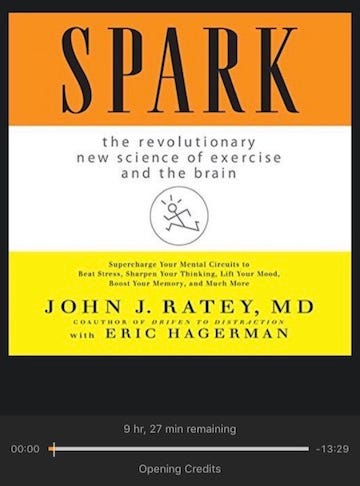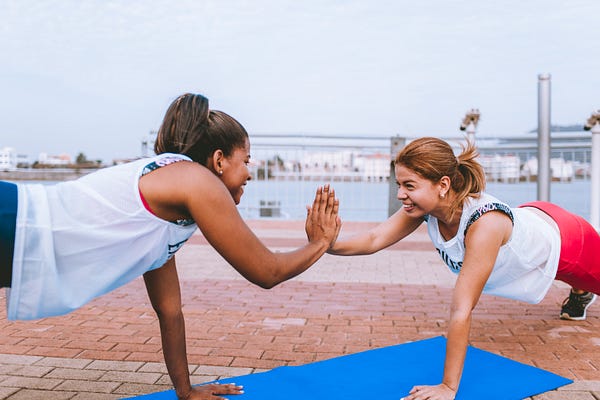Spark by John Ratey

This book intrigued me because I knew that there was a link between exercise and so many other aspects of our health. But, I did not know the science behind it, especially at this depth. Right away, the book began with a nice example of the science in action — through a school district. This district not only boasted high test grades but also a less than 10% obesity rate for its student population. While the book, yes, was published in 2008 and I might be a little late to learn more about some of these findings, they excited me nonetheless.
I’m always interested in different educational statistics. What has happened and why. What students are performing better and why. After thinking about myself and my personal experience, the following data did not surprise me.
Students with a higher standard of living scored higher on tests shown by CDE, when factoring in socioeconomic factors though, fitter kids scored better than unfit kids.
The author shared the next important note which I think encompasses the overall idea of the book — the goal is a life of fitness and thereby health, holistic health. To get there, the following is so important and I totally agree. My mom loves to run, but running is something that I have yet to become passionate about, I’d rather run sprints and train hard rather than run 5 miles, even if just for fitness.
It’s important to find something in fitness that allows the person to excel, something that feels like them when they’re doing it.
The following quote from the author shares the ideology of the book in simple form.
“Better fitness = better attention = better results”
Often, I do not believe that the average person reflects upon how our lives are now compared to how they used to be. If you live in an urban area you might take a train or bus or car somewhere but often, that cuts the walking distance down dramatically. If you’re living in the suburbs or elsewhere, likely a car may be the most frequent mode of transportation. We really do not have to exert ourselves too much physically to get where we want to go, but it was not always like that. Dr. John Ratey wrote,

Our lifestyle today is both more stressful and more sedentary. With chronic stress, our body stockpiles energy around our midsection.
And to follow up on the previous highlighted portion, thinking again about holistic health, I often ask myself how can I operate at peak efficiency. Here’s something for all of us to remain conscious of,
The more stress you have, the more your brain needs to move to keep everything running smoothly.
Below is just the most simple thing, it’s almost obvious once you understand it. I’ve noticed it within myself, on days when I don’t work out, I am more high strung and moody than on days when I do get in a workout. It’s just crazy to see how much more successful people become when they take their health and fitness seriously.
Physical activity lowers the resting tension of muscles and interrupts the anxiety feedback loop to the brain. If the body is calm, the brain is less prone to worry.
Wow. I listened to this about 10 times in a row. The chapters were broken down by topic and many of those topics were different things like anxiety, depression, stress, etc. I wasn’t surprised that someone with anxiety might respond the same way to a situation that was legitimately frightening though I had not before understood the difference in responses in a typical situation. Dr. John Ratey shared the difference in diagnosis within the brain,
The amygdala responds differently within brains of people who have anxiety versus those who don’t. While it responds the same in legitimately frightening stimuli, the difference is in how they respond to non-threatening stimuli. They cannot discriminate between danger and safety.
And here was the science part of the reason that exercise really calms us. While ANP (Atrial Natriuretic Peptide) is naturally produced in 2 places in the brain, it is secreted by our heart during exercise. Wow. That’s incredible. I was just in awe of the amazing bodies that God has blessed each of us with since creation. All that we need, all health, it’s within us — and that’s by design.
ANP (Atrial Natriuretic Peptide) is secreted by heart muscles when we exercise and makes its way through the blood-brain barrier. It attaches to receptors in the hypothalamus to modulate HPA access activity. It is also produced in 2 places in the brain. ANP has been shown to have a calming effect. Levels of ANP triple in women during pregnancy suggesting a built-in survival strategy to protect the baby from the toxic effects of stress and anxiety.
There were no true reflection points to the following for me. I just loved learning about different things that exercise naturally does for the body and brain. Here are the seven that the author listed:
Cognitive restructuring of fear — exercise reduces stress for the body and the brain by:
1. Provides distraction, puts mind elsewhere as do other practices but lasts longer
2. Reduces muscle tension, serves as a circuit breaker
3. Builds brain resources, exercise increases serotonin and norepinephrine
4. Teaches a different outcome, associate physical symptoms of anxiety with something positive
5. Reroutes your circuits
6. Improves resilience, self- mastery, begin to realize you can do something for yourself because you ARE doing something for yourself
7. Sets you free, exercise helps you move towards something
I always strive to workout near exertion levels. If I’m on a machine that measures heart rate, I strive for a 185–190 heart rate for at least 5 minutes during the workout. I take shorter breaks or rest times between exercises for the same reason. I desire the greatest possible impact on my body from my workouts and exercise.
HGH is something that I have studied and learned about. I learned from my chiropractor that while the human body naturally produces HGH, after 10:00, the production decreases. By 10:30, we are only producing 50% of the possible HGH, by 11:00, we’re down to 15%, and by 12:00 am, no HGH is being produced. So talk about the importance of a disciplined bedtime! Beyond that, I learned from numerous places, which was also repeated in this book, that HGH production decreases with age also. Here’s what the author had to say about HGH,
Once you get closer to your maximum heart rate, the pituitary gland in your brain unleashes HGH.
This book was a great one. One of the most informative of the year and definitely some things within it that can be immediately applied, to myself and others. I love learning and studying the way that our bodies are built and wired.

Something that stood out but I did not highlight was the measurement that the author continued to emphasize. He said that the best way to measure our health and fitness is with a heart rate monitor. The reason there is we are all different physically and while someone might achieve a 180 HR when running a 5-minute mile, someone else might experience the same heart rate when running a 9-minute mile. That doesn’t make one person healthier than the other and surely does not mean one person has better fitness levels.
I gave this book a 4/5